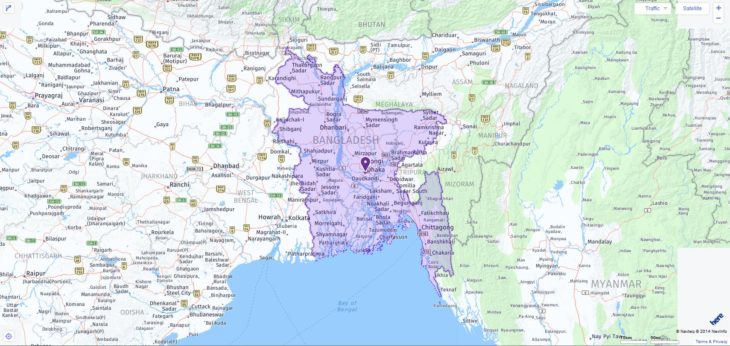Your search found 1 match. The following is the full list of ACT testing locations in Bangladesh among which you can pick one to take the exam. Please know that on the test day, test takers can use any 4-function, scientific, or graphing calculator. On the table below, you can also find all test dates through 2019.

2019-2020 ACT Test Dates in Bangladesh
| Test Date | Registration Deadline |
| February 9, 2019 | January 11, 2019 |
| April 13, 2019 | March 8, 2019 |
| June 8, 2019 | May 3, 2019 |
| July 13, 2019 | June 14, 2019 |
| September 14, 2019 | August 16, 2019 |
| October 26, 2019 | September 20, 2019 |
| December 14, 2019 | November 8, 2019 |
| February 8, 2020 | January 10, 2020 |
| April 4, 2020 | February 28, 2020 |
| June 13, 2020 | May 8, 2020 |
| July 18, 2020 | June 19, 2020 |
ACT Test Centers in Bangladesh
| City | Center Name | Center Code |
| Dhaka | American International School | 870590 |
More about Bangladesh
Climate
Bangladesh has a tropical to subtropical monsoon climate. The northeast monsoon ensures dry air and average temperatures of 19 ° C in the winter months (November to March). In the hot summer months with temperatures between 28 ° C and 40 ° C, the country is in the area of influence of the rain-bringing southwest monsoon (June to October). In almost every part of the country there is more than 1500 mm of annual precipitation. T. up to 5000 mm. The coincidence of river floods (melting snow in the Himalayas), monsoons (southwest monsoons) and tropical cyclones in the Bay of Bengal often lead to devastating flood disasters (1970: 300,000 deaths, 1991: 150,000 deaths). The one under climate change observed rise in sea level exacerbates the extent of the disaster. The penetrating seawater leads to increasing salinization of the groundwater.
Vegetation and wildlife
In total, only 11% of the country’s area is forested. The original flora and fauna were either destroyed by the expansion of agricultural land or they were displaced into small, remote refuges. Evergreen rainforest can be found in the Chittagong Hills as well as in remnants inland. The Sundarbans have the largest mangrove forests in the world.
The “beautiful forest” in Bangladesh
The “beautiful forest”
The swampy mangrove forests form the transition from the tropical rainforest to the coast. The largest contiguous mangrove forest in the world grows on the coast of the Bay of Bengal, in the branched delta of Ganges and Brahmaputra on the border between India and Bangladesh. The approximately 6,000 square kilometers large forest area Sundarbans (“beautiful forest”) was placed under protection by UNESCO in 1987/97 and declared a World Heritage Site. The mangrove forests represent a unique and effective ecosystem that protects the coast from cyclones and floods. The trees need brackish water, which is mixed with fresh and salt water. Their widely ramified stilt roots give them support in the silt, and the sediments of the flowing water are deposited on them. Similar to coral reefs, they play an important role as a »nursery« for fish, Prawns, crabs and other marine life. These find shelter under the stilt roots of the mangroves and rich food in the silt. In addition to many rare plant species, there are numerous animal species that have adapted to the extreme conditions with daily fluctuating water levels and high salt concentrations. The mudskipper, for example, is a fish that can breathe in the water as well as in the air and ventures into the roots of the mangroves. The Sundarbans are an important refuge for the Bengal tiger after its original home, the tropical rainforests of the Himalayas, have been largely deforested. According to the last count, a good 100 tigers still live in the mangrove forests. the tropical rainforests of the Himalayas, have largely been deforested. According to the last count, a good 100 tigers still live in the mangrove forests. the tropical rainforests of the Himalayas, have largely been deforested. According to the last count, a good 100 tigers still live in the mangrove forests.
The people living in the mangrove forests have always taken care of themselves from the forest. Honey, mussels, crabs, plants and firewood were used solely for self-sufficiency and conserved resources. Today the mangroves are threatened. Poaching and overfishing threaten animal populations. More and more people take care of themselves from the forests, some of them are cut down to make space for shrimp farming. The dykes required for the breeding facilities also threaten the existence of the mangrove forests because they interrupt the important tidal current. The consequences are dramatic: The lack of forests allows the tropical storms to hit the coast unhindered, the sea water presses into the estuaries and causes the rivers to swell, which eventually overflow their banks far in the hinterland, drowning the land “from behind”.
Bangladesh has an extremely diverse fauna, but the habitat of the animals is increasingly restricted by the high population density. Deer, rhesus monkeys and elephants can be found in the remaining rainforests of the Chittagong Hills. The humid sundarbans populate crocodiles, snakes, turtles, birds, and fish. Around 100 Bengal tigers still live in the protected mangrove forests. After the population had declined sharply in the last few decades, it has been increasing again since 2010 as a result of increased efforts to protect tigers.

